 In my article,
“A Look at the Wounds of Governor Connally,”[1]
I concluded that the Warren Commission had
erred in finding that Governor Connally was struck by the same
first bullet or bullets which wounded President Kennedy. After
further study of the material, some of which was not available
for intensive examination at the time the above mentioned article
was written, it is possible to reaffirm and buttress this
conclusion. In addition, in a
sequel to this presentation, it
will be possible to offer evidence which suggests a possible
answer as to when Governor Connally was actually wounded.
In my article,
“A Look at the Wounds of Governor Connally,”[1]
I concluded that the Warren Commission had
erred in finding that Governor Connally was struck by the same
first bullet or bullets which wounded President Kennedy. After
further study of the material, some of which was not available
for intensive examination at the time the above mentioned article
was written, it is possible to reaffirm and buttress this
conclusion. In addition, in a
sequel to this presentation, it
will be possible to offer evidence which suggests a possible
answer as to when Governor Connally was actually wounded.
Our articles in Liberation[2] established, through the study of the Warren Commission’s own evidence on the shots, trajectories, and wounds of the assassination, that more than one gunman was firing at the Presidential motorcade on November 22, 1963. The present article further reinforces the conclusion of multiple assassins. Governor Connally’s wounding holds certain vital clues to the question of how many assassins were shooting at the Presidential motorcade. The Commission hastily and wrongly concluded:
... It is not necessary to any essential findings of the Commission to determine just which shot hit Governor Connally ...[3]
In so concluding the Commission ignored elementary arithmetic. Once we establish that a separate shot hit Governor Connally, a fourth bullet is added, and another gunman appears in the assassination picture.
For one must recall that the Commission was confined by the short time span of the assassination shots to the allegation of only three bullets, one of which had: “... probably missed the Presidential limousine and its occupants ...” (W-117) Another bullet hit the President in the head. This left but one bullet to perform all the other wounding. Consequently, the Commission concluded that the first shot to strike the President performed the heavy, and double duty of first piercing his back and throat, then Connally’s chest, fifth rib and right wrist, and finally of entering the left femur. Thus the Commission’s contention that no more than three shots were fired. Should this tight little system of logic, based on three bullets and a weaving hit, collapse, so would also the lone assassin theory. Our primary purpose in this article is to demonstrate that the double or joint-hit theory of the Commission relating to the Connally wounding is against the overwhelming weight of the evidence. In a future article we will also tentatively suggest a point in time at which an assassin delivered a strike on the Governor.
The Number And Timing of Shots
The last hit in the President’s head could not have also caused all the Governor’s wounds. Dr. Alfred G. Olivier, a government ballistics expert, ruled out the possibility that the wounding of the Governor’s wrist could have been caused by a fragment of a bullet coming from the President’s head.[4] The Commission agreed with Dr. Olivier. (W-586) One is safely able to deduce the following: if the wrist wounds of Governor Connally were unlikely to have been produced by bullet fragments deflected from the President’s head, then it is far more unlikely that all the Governor’s wounds could have been inflicted by these fragments.
Dr. Olivier demonstrated that the last shot striking the President in the head could not have caused all of Governor Connally’s wounds. The Commission asserted that one shot “... probably missed the Presidential limousine and its occupants.” (W-111) Once the joint hit is disproved, we have at least one shot hitting the President in the back, one shot missing, and a fourth shot and a second assassin are required to register a separate hit on the Governor.
A fourth shot dictates a finding of at least two gunmen.
The proof of a separate missile strike on the Governor also demolishes the Commission’s single-assassin structure by disrupting the delicately balanced time elements of the assassination shots. Once the time considerations are disturbed by a separate hit on the Governor, another assassin must be placed in the picture. The Commission admitted that if the assassin had hit the Governor with a separate shot between the first and last hits on the President:
... the gunman would have been shooting at very near the minimum allowable time to have fired the three shots within 4.8 to 5.6 seconds. (W-117)
Thus a separate strike on the Governor strains the minimum allowable shot time required for any gunman, no matter how expert, to fire three shots from the rifle alleged to have performed all the work of the assassination. In addition to the problem of firing this rifle three times in the allowable time span, there was the difficulty of aiming three shots accurately. The Commission was unable to solve the accuracy obstacle when it was combined with the shot time factor. Using stationary—not moving—targets the Commission’s marksmen could only obtain two hits (W-194), and not the required three, within the 4.8 to 5.6 seconds which elapsed between the President’s neck and head hits. (W-117) Hits on two of the limousine’s occupants, seated one in front of the other, would have required a high degree of accuracy of one assassin positioned in the rear.
Also confronting the Commission was another barrier. If there was a separate strike on the Governor, between the first and last hits on the President, then the shots had to be locked into evenly divided intervals. The Commission concluded:
... if the three shots were fired within a period of 4.8 to 5.6 seconds, the shots would have been evenly spaced ... (W-193)
Therefore, approximately equal 2.5 second periods would have lapsed within the 4.8 to 5.6 second time. The time span of the assassination is precisely ascertainable from the Zapruder motion-picture films. For we know from the FBI studies that 18.3 pictures or frames were taken by the Zapruder camera during each second of the assassination. By allowing 1/18.3 second from one frame to the next, we can measure the time span of the assassination with a high degree of precision. (W-97)
The earwitness evidence falls heavily against the conclusion of evenly spaced shots:
... a substantial majority of the witnesses stated that the shots were not evenly spaced. Most witnesses recalled that the second and third shots were bunched together. (W-115)
The weight of the evidence—which is much against even spacing of shots—compels us towards the conclusion that if there was a separate hit on the Governor, and in addition there was a bunching of two or more shots, then the 4.8 to 5.6 second time-box is shattered. In such a case, more than three bullets are revealed to be at work. Why does any bunching in the allotted time span, when combined with a separate hit on Connally, destroy the single assassin theory? To bunch two shots within the 4.8 to 5.6 second time span is to dip within the 2.3 second minimum period required for firing two shots from the alleged assassination weapon. The Commission concluded: “ ... at least 2.3 seconds were required between shots.” (W-97) The rifle chosen as the single source of all the assassination shots, when worked within the physiological limits of even the most expert marksmen, required 2.3 seconds between shots in rapid fire tests. The rifle was not operated by the Commission marksmen in faster time. (W-97)

|

|
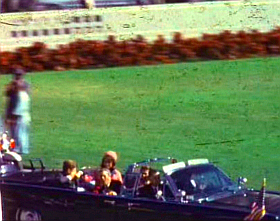
|
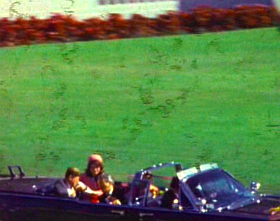
|

|
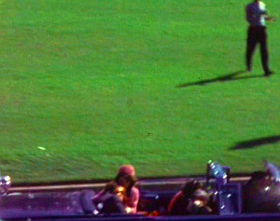
|
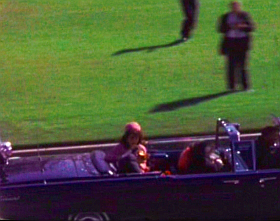
|
If a separate hit on Connally is established, and the 2.3 second minimum period required for firing two shots is compressed into something less by bunching, then, by inference, a second assassin emerges. This assassin perforce fires from a gun other than the bolt-action Carcano from which the Commission alleged all the shots of the assassination emanated.
We leave, for now, the bunching problem. But one should keep in mind the importance of the bullet-bunching evidence. Further analysis of bunching will be undertaken in another context, later in this article.
Governor Connally, according to the Commission, was struck by “ ... the same bullet which pierced the President’s throat ...” (W-19) Upon considering the Zapruder slides, we learn that at frame 225—the point at which the President was determined by the Commission to have been hit—that the Governor is sitting erect and facing forward in the Presidential limousine. Connally registers no evidence of being hit at this point; the President does.
At frame 221 the Governor comes into the path of the Zapruder lens. He is facing northward towards the grassy knoll. At frame 225—when the President’s first reaction to his neck wound is recorded—Connally can be seen facing front and westward. At frame 235 he commences the right turn which, when completed, faces him fully northeastward.
To have the Governor turn right with one lung pierced (XVII, H-17), while shouting (IV, H-147)—to have him turn against the tremendous force of the bullet which shattered his right fifth rib, right wrist, and left femur (W-19)—would be to have him accomplish the implausible. The Commission, by concluding that Connally made such a turn after being hit in the extreme right of his back, did violence to Newton’s third law of motion.
The law of action and reaction would require that Governor Connally be immediately thrust forward and leftward by the impact of a bullet fired from behind and striking him while he sat erect and looking straight forward. According to the government version. Governor Connally failed to register an impact at all at frame 225. He failed to fall until around frame 300. Connally’s body was maintained in a sitting position for more than 75 Zapruder frames after the Commission alleged he was struck, or for more than 4 seconds after the missile allegedly ploughed through him.
Mrs. John Bowden Connally’s testimony is not reconcilable with the Commission’s version:
Then very soon there was the second shot that hit John ... and as he recoiled to the right, just crumpled like a wounded animal to the right, he said, “My God, they are going to kill us all.” (IV, H-147)
Mrs. Connally’s statement is, in all respects, contrary to the Commission findings. First, she recalled a separate hit on the Governor. Second, she did not recall a 4 second lapse between the strike on the Governor and his reaction to the hit. She describes the reaction as a “recoil.” Thirdly, although the bullet entered on the Governor’s extreme right and crossed over leftward at 27° (IV, H-138), we are asked by the Commission to believe Connally was driven by the force of this leftward strike to his right while he was sitting erect and facing straight ahead. Mrs. Connally’s recollection of this shot driving her husband to the right is only compatible with a tangential strike while the Governor was in the process of turning.
Governor Connally’s recollection was that he was struck by a separate bullet which hit him after he had turned right, and after he had commenced turning left. (IV, H-138-139) There is no doubt in the Governor’s mind that he was hit by a shot which was other than the first rifle shot. In describing his hit he stated:
... the best way I can describe it is to say that I would say it is as if someone doubled his fist and came up behind you and just with about a 12-inch blow hit you right in the back right below the shoulder blade.
Senator Cooper. That is when you heard the first rifle shot?
Governor Connally. This was after I heard the rifle shot. (IV, H-144-145)
The Commission’s findings had to be made contrary to the requirements of the physical laws of motion and against the testimony of the Governor and Mrs. Connally. Nonetheless, the Commission found that the Governor was hit by the same first bullet which hit the President.
Connally’s wrist wound caused the Commission obvious problems. It turned out that the Commission’s joint hit theory designated a period for the infliction of the Governor’s wounds when his right wrist, in order to receive a strike while he was sitting erect, had to be visible to the Zapruder camera lens. Unfortunately for the Commission’s view of the Connally wounding, the wrist was invisible at the time the Governor was supposed to be receiving his wounds.
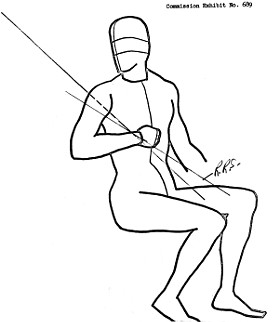
|
Commission Exhibit 689 (XVII, H-346) shows what the Commission would have had to find with respect to the right wrist alignment of the Governor if he were hit circa 225 while he was sitting erect and facing straight forward. Commission Exhibit 689 shows him in a sitting position, with the under, or volar, aspect of the wrist facing the chest area, and the thumb, or dorsal, aspect of the wrist facing outward. The bullet is shown by the Commission Exhibit to pass through the chest of the Governor, enter the right wrist from the under, or palm, side, and exit from the back, or dorsal, side. Although this is what the Commission had to conclude for the path of the bullet to be compatible with a strike from the back of the Governor while he was sitting erect and facing straight forward, the Commission was confronted with a tremendous amount of contrary and convincing evidence which did not support a volar or palm-side hit. In fact, the wrist was totally invisible in the Zapruder frames at the point when the President first registered a hit. Therefore, the Commission was confronted with the serious matter of having to conclude that a wrist was struck with a bullet when that wrist was not visible at the spot it should have been in to receive the bullet.
Dr. Charles Francis Gregory of Parkland Hospital, through excellent and meticulous work, settled for history that the Governor’s right wrist was struck first from the back, or dorsal side. He first pointed out that the bits of thread from the Governor’s suit and coat were carried into the dorsal side of the wrist. (IV, H-120) Then, Dr. Gregory proceeded to discuss the compelling X-ray proof of an entry through the thumb side of the wrist. He pointed out how X-rays of the wrist revealed metallic substances—fragments left by the missile as it passed through. The X-ray recordings of the path of these metallic substances told Dr. Gregory that they were flaked off from a missile which coursed through Connally’s wrist: “From the back of the wrist to the palm side.” (IV, H-120) Dr. Gregory persuaded the government ballistics expert, Dr. Olivier, that the bullet’s direction through the wrist was from dorsal, or thumb, side to volar, or under, side. (V, H-83) So, the Commission had to reject Exhibit 689 in so far as it bore on the course of the bullet which caused the wounds to the Governor’s wrist. (W-94)
In rejecting Commission Exhibit 689, with respect to the bullet path through Connally’s wrist, the Commission was immediately compelled to conclude that Connally was holding his right wrist under his right nipple in a contorted fashion so that the thumb, or dorsal, side of the wrist was confronting his right anterior chest.
In addition to this problem of contortion, the Commission had another problem of the wrist which failed—with all the Commission’s twisting—to fall into alignment. Zapruder frames 221 through 226 (the latter frame being the point at which the camera clearly records the President’s first definite reaction to his initial hit or hits) revealed to us that Governor Connally’s right wrist was not to be seen at all in front of his chest.
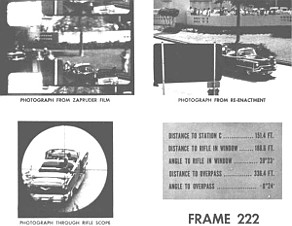
|
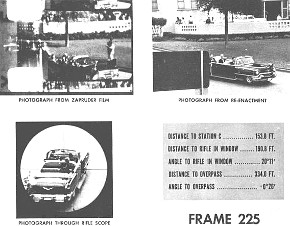
|
In this respect the FBI reenactments of frames 222 and 225 are in perfect agreement with our observations of the Zapruder frames. (C. E. 894 and 895, XVIII, H-89-90) The reenactments show the stand-in for Governor Connally not having his right wrist anywhere near his right anterior chest. The agent’s right anterior chest is clearly visible in these exhibits, but his wrist is not visible. Unless the Governor’s right wrist had been visible around his chest area at the time of the first strike on the President, the Commission was not justified in determining that this shot pierced the President and then Governor Connally at or about Zapruder 225. Dr. George T. Shires thought that the Governor’s wounds could be better explained on the basis of his being in the act of turning when he received them and not having been in an erect and straightforward sitting position. (VI, H-111) The following testimony indicates that Dr. Shires felt the Governor’s right arm, to be consistent with the Commission’s joint hit theory, had to be drawn in front of the Governor’s chest and next to the exit wound:
Mr. Specter. [Arlen Specter, Assistant Counsel for the Commission]. Assuming an angle of declination of approximately 45 degrees.
Dr. Shires. This I don’t know without drawing it out, but as long as his right arm is drawn in front of him next to the exit wound on the chest, he is in a sitting position, if the angle of declination was right, then I think he could have received this facing straight forward. (VI, H-110)
The angle to a rifle in the window of the Book Depository Building at frame 210 is approximately 18 degrees, and is 17 degrees at frame 225. (W-102-103) In view of this, how did Arlen Specter get a trajectory of 45 degrees through Governor Connally? What caused Specter to exaggerate the angle of the bullet downward? Robert A. Frazier, FBI firearms expert, established the angle of the back to the front of the Governor’s shirt at “approximately 30 degrees.” (V, H-72) There is no evidence whatever to support a 45 degree downward course through Connally.
It would have been most convenient for the Commission’s view to have a trajectory distorted deeply and steeply downward. In the event of a 45 degree steeply-downward trajectory, the wrist would not have had to show above the side panel of the automobile. If the 45 degree trajectory were fact, and not fancy, the wrist’s invisibility to the Zapruder camera lens would not doom the Commission’s joint-hit theory.
No wonder, therefore, that Specter was reluctant to give up on the unwarranted and unproved 45 degree trajectory:
Mr. Specter. ... if you assumed a trajectory with an angle of decline approximately 45 degrees?
Dr. Gregory. I believe that the three wounds could have occurred from a single missile under these specifications. (IV, H-127)
As prerequisite to accepting the Commission’s version of the injury to the right wrist of the Governor, we are confronted with the need to embrace the following doubtful propositions: First, the Governor’s right wrist was up under his right nipple at about frame 225, when in fact, the Zapruder films show it was not there. Second, the Governor, for some inexplicable reason—not having any memory of having done so, and not having been reported to have done so by any eyewitness, and not having been recorded by the motion pictures as having done so—contorted his wrist immediately prior to having been struck by a missile so that the thumb, or dorsal, side faced his upper anterior chest. Third, either the trajectory through Connally was 45 degrees—although the Commission has told us that this was the same bullet which without having struck bone, supposedly traversed the President in a 17 or 18 degree angle of declination (W-88)—or, if the trajectory was not 45 degrees, the bullet pierced an invisible right wrist.
From the problem of a twisted-invisible wrist we will turn our attention to another key aspect of the Commission’s joint-hit concept, the ballistics consideration.
Here we will deal specifically with the ballistics problems of Commission Exhibit 399. (XVII, H-49) The Commission designated 399 for the bullet which inflicted the back and neck wounds of the President and the back, chest, wrist and leg wounds of the Governor. The Commission flatly asserted:
All the evidence indicated that the bullet found on the Governor’s stretcher could have caused all his wounds. (W-95)
A review of “all the evidence” indicates how sorely mistaken was this sweeping assessment.
FBI firearms expert Robert A. Frazier expressed what could at best be described as cautious, noncommittal skepticism on the question of one bullet passing through the President and the Governor between frames 207 and 225:
... I myself don’t have any technical evidence which would permit me to say one way or the other, in other words, which would support it as far as my rendering an opinion as an expert. (V, H-172)
Mr. Frazier studied the question and concluded that he did not have “any technical evidence” indicating a double hit by 399. Mr. Frazier made another fascinating statement which remains unexplained:
I have not made a very thorough study of the Zapruder film ... (V, H-169)
Considering the importance of the Zapruder film and the competence and high caliber of Mr. Frazier’s work, we query the cause for his not choosing to undertake an intensive study of the material having direct bearing on his area of expertise.
Commander James J. Humes of the Bethesda Naval Hospital, who had offered testimony which provided heavy support for the Commission’s ultimate findings, even if based on no evidence, balked on the 399 point. He indicated that the X-ray evidence showed metallic fragments in the Governor. Commander Humes confronted the 399 theory simply and emphatically and without any element of doubt or confusion stated:
I can’t conceive of where they came from this missile. (II, H-376)
Lt. Col. Pierre A. Finck, also of Bethesda, shared Dr. Humes’ dim view with respect to whether 399 could have caused Connally’s wrist wounds:
No; for the reason that there are too many fragments described in that wrist. (II, H-382)
These statements of Drs. Humes and Finck are categorically against the double hit concept.
Dr. Robert Roeder Shaw of Parkland Hospital was equally definite in his conviction that 399 did not cause the Governor’s wrist wounds:
... the examination of the wrist both by X-ray and at the time of surgery showed some fragments of metal that make it difficult to believe that the same missile could have caused these two wounds. There seems to be more than three grains of metal missing as far as the—I mean in the wrist. (IV, H-113)
Let us also consider the weight of 399 and its relationship to the metal which it is supposed to have deposited while allegedly passing through the President and the Governor. Bullet 399 weighed 158.6 grains. (W-95) Frazier tested a number of bullets similar to 399 for purposes of determining the weight of an intact bullet. He said:
They were all in the vicinity of 161 grains. One weighed 160.85, 161.5, 161.1 grains. (III, H-430)

|

|
If a weight combination of the metal extracted from Connally, that remaining in his body, the residual metal in the President’s clothing, back, and neck, exceeds 2.9 grains, it would be impossible to accept Exhibit 399 as the only missile inflicting the wounds. For the difference between the weight of 399 (158.6 grains) and the heaviest test bullet reported by Frazier (161.5 grains) is 2.9 grains. The Commission’s conclusion of a double hit would be reduced to quantitative absurdity.
Mr. Frazier stated that a fragment of metal removed from Connally’s arm, C.E. 842 weighed .5 grains. (XVII, H-841) Dr. Shaw estimated the number of grains missing in the wrist as more than three. (IV, H-113) An estimate by Dr. Shires of the fragments remaining in the Governor’s left femur was .10 grains. (VI, H-106) Dr. Gregory spoke of the X-ray findings of the Governor’s right wrist. He stated that the X-rays reveal seven or eight fragments, and “... experience has taught that when these things are dismantled directly under direct vision that there very obviously may be more than that.” (IV, H-120)
Exhibit 399 was determined by the Commission to have pierced the coat of the President; therefore, we are compelled—in the context of the government’s weaving-bullet concept—to conclude that any copper traces on the coat would have had to result from 399’s passage. FBI Agent Frazier described President Kennedy’s coat: “Traces of copper were found around the margins of the hole in the back ... foreign to the coat itself.” (V, H-59) Since the Commission had only 2.9 grains to spare, even this small residue of copper represented a weighty problem for the interlacing-bullet concept.
Mr. Frazier was not even able to say whether Commission Exhibit 399 had suffered any weight loss at all. When the question was put to him concerning how much weight loss 399 had suffered, he said: “There did not necessarily have to be any weight loss to the bullet.” (III, H-430)
Commander Humes, Lt. Col. Finck, and Dr. Shaw had no doubt that 399 did not produce Governor Connally’s wounds. They emphatically advised the Commission accordingly. The Commission, without having any evidence to contravert these experts and their emphatic opinion that 399 did not cause Governor Connally’s wounds, found, against all the evidence, that 399 had accomplished a joint hit which included the infliction of all the Governor’s wounds.
We will now demonstrate how the Commission through the legerdemain of calling no evidence, or contrary evidence, all the evidence manages to surmount the insurmountable problems of the 399 theory.
A Bullet’s Miraculous Resiliency
“All the evidence,” the Commission contended, supports its weaving-bullet theory. (W-95) Actually, all the evidence which the government could muster in support of the idea that 399 did inflict the wounds on the Governor was meager indeed. Dr. Alfred G. Olivier, the government ballistics expert said with reference to whether 399 was responsible for causing the Governor’s wrist wound: “Yes I believe it was.” (V, H-90) Dr. Frederick W. Light, Jr., also a government ballistics expert, evidently had little confidence in the tests of his colleague, Dr. Olivier. For on the basis of Dr. Olivier’s reconstruction tests and anatomical findings he could conclude nothing:
I would say I don’t feel justified in drawing a conclusion one way or the other on that basis alone. (V, H-97)
Dr. Olivier’s “reconstructions” are not worthy of serious consideration. No court in our land would have allowed them to be offered as evidence. He, in an effort to duplicate the Connally wounds: “fired ... at comparable flesh and bone protected by material similar to the clothing worn by the Governor.” (W-95) Dr. Olivier’s tests are useless. They fail to reconstruct the conditions alleged to have occurred in the 399 theory as a continuing series of events. At no point did the government experts attempt to pass one bullet through “flesh and bone” representing both the President and the Governor. At no time are we given any indication of what each of the bullets looked like after making their way through the test material. The test bullets all should have been Commission exhibits. But only one bullet, C. E. 854 (XVII, H-849), was shown. This bullet was more flattened and more irregular than C. E. 399. One is left to imagine the state of damage in which the other bullets were after passing through the simulated flesh and bone structure comparable to that of the Governor alone. How much more damaged would these bullets be if they were passed through material roughly equivalent of both the President and the Governor!
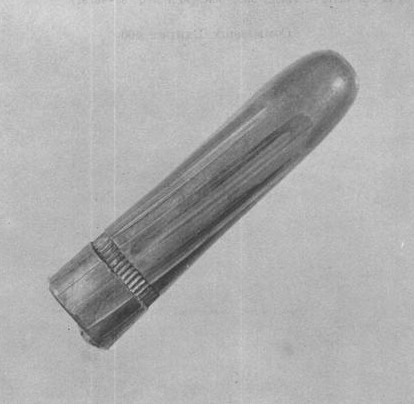
Commission Exhibit 399
|
It is difficult to believe that Dr. Olivier and the Commission staff knew no better reconstruction techniques. They may have known too well the improbability of duplicating the Commission’s 399 theory with an accurate reconstruction. We now request of the government that they produce the other test bullets for examination at the National Archives so that they can be compared with 399.
No wonder Dr. Light refused to draw any conclusions concerning 399 from the “reconstructions” alone. He based his assumption that both men were hit by 399 on “their positions in the automobile.” (V, H-97) That this was Dr. Light’s mistake is dramatically indicated by the Zapruder films and the wrist problems. No alignment of the President and the Governor accomplished in a reconstruction or diagram is to be found anywhere in the Warren Report or the hearing notes and exhibits. Dr. Light was clasping an invisible wrist in order to support the government 399 concept by the “positions in the automobile.”
Dr. Arthur J. Dzieman, another government employee, supported the Commission with a statement on the joint hit: “I am saying that the probability is high that that was so.” (V, H-92) But Dr. Dzieman made a shocking statement when asked whether he had “an opportunity to observe certain ... Zapruder films”. His reply: “No; I did not see those.” (V, H-92) Well, since there were no reconstructions of the President and the Governor being struck with a joint hit, and no explanatory joint hit diagrams shown anywhere in the record, and since Dr. Dzieman failed to view the Zapruder films, one is left to wonder on what undisclosed evidence he based his statement in support of the joint hit hypothesis.
None of the three doctors attached to the government who agreed with the double-hit theory mentioned viewing the Zapruder films, nor did they mention the position of Connally’s right wrist during the supposed joint hit. None dwelt on the number and weight of the fragments remaining in the Governor which were too many and too heavy to have flaked off from 399. None mentioned the problem of the irregularity of the missile which pierced the Governor, nor the regularity of 399. They noted nothing of the evidence provided by the Connally X-rays which cast light on the path of the bullet. None dared employ emphatic language, and not having examined, or having ignored, the crucial evidence, they were wise to avoid employing assertive language. And so they mustered up: “I believe that it was. That is my feeling.” (V, H-90); “... I would say I don’t feel justified in drawing a conclusion one way or the other on that basis alone.” (V, H-97); “I am saying that the probability is high that that was so.” (V, H-92)
This halting language is the sum total of support that the Commission had for its 399 theory. On the basis of this the Commission asserted:
All the evidence indicated that the bullet found on the Governor’s stretcher could have caused all his wounds. (W-95)
No twisting of logic and evidence will support this unwarranted assessment of the record. If “all the evidence” supported the 399 theory, then what shall we call all the following material which the Commission marshaled and ignored? Let history render an objective judgment on whether the following does not constitute “evidence”—conclusive evidence—that 399 did not accomplish a double hit on the President and the Governor.
Consider briefly the material already explored which contradicts the 399 theory. Dr. Shaw of Parkland ruled out 399 as the cause of all the damage in the Governor by asserting flatly that more than three grains of metal were deposited in the Governor’s wrist. Dr. Shaw’s observations were made first hand from X-ray examination and surgery. Dr. Gregory dwelt extensively on the fragments which the X-rays tell us were spewn through the Governor. FBI Agent Frazier spoke of the metallic deposits on the President’s coat. Yet the overwhelming weight of the evidence indicating more than 2.9 grains of additional bullet weight did not deter the Commission from its ultimate conclusion. It ignored all the evidence that indicated that the 399 bullet could not have accomplished the tremendous amount of tissue destruction and fragment shedding—and still look and weigh like 399.
In contrast to the halting support of Drs. Olivier, Light and Dzieman, compare the solidly committed language of the opposing experts who, after having considered the relevant evidence, flatly and emphatically rejected the 399 theory.
Commander James J. Humes said about 399’s possible involvement in the Connally wounding:
I think that extremely unlikely.... X-rays taken ... described metallic fragments in the bone, ...I can’t conceive of where they came from this missile. (II, H-376)
Lt. Col. Pierre A. Finck said:
No; for the reason that there are too many fragments described in that wrist. (II, H-382)
Dr. Gregory treated the wounds in the wrist of the Governor. What he said about the irregular shape of the missile which struck Connally’s wrist clearly distinguishes it from the regular shaped 399:
Dr. Gregory. The wound of entrance is characteristic in my view of an irregular missile in this case, an irregular missile which has tipped itself off as being irregular by the nature of itself.... I mean one that has been distorted. It is in some way angular, it has edges or sharp edges or something of this sort. It is not rounded or pointed in the fashion of an ordinary missile.
Dr. Shaw also stated:
... the examination of the wrist both by the X-ray and at the time of surgery showed some fragments of metal that make it difficult to believe that the same missile could have caused these two wounds. There seems to be more than three grains of metal missing as far as the—I mean in the wrist. (IV, H-113)
I feel that there would be some difficulty in explaining all of the wounds as being inflicted by bullet Exhibit 399 without causing more in the way of loss of substance to the bullet or deformation of the bullet. (IV, H-114)
From the pictures, from the conversation with Governor Connally and Mrs. Connally, it seems that the first bullet hit the President in the shoulder ... but this was the bullet that Governor Connally feels hit him; and in the sequence of films I think it is hard to say that the first bullet hit both of these men almost simultaneously. (IV, H-114)
Dr. Shires only discussed possibilities. He supported as possible other theories which were contrary to the 399 idea:
Mr. Specter. Do you think it is possible that Governor Connally could have been struck by two bullets, one entering his back and emerging from his chest and the second going into his wrist?
Dr. Shires. I’m sure it is possible... (VI, H-110)
On the basis of the above testimony, Drs. Gregory, Shaw and Shires are cited by the Commission for endorsing the 399 theory. “In their testimony, the three doctors who attended Governor Connally at Parkland Hospital expressed independently their opinion that a single bullet,” to wit, 399, had caused all of Connally’s wounds. (W-95) No critic of the Warren Report could expect to get away with such patently incorrect citations, nor in the interest of fairness should he. In light of the above testimony, how could the Commission have fairly concluded “all the evidence” supported the idea that 399 had struck Governor Connally and caused all his wounds?
- From “The Warren Report?”, Liberation, March, 1965. [↩]
- Endnote 1 and “A Philadelphia Lawyer Analyzes The Shots, Trajectories and Wounds,” Liberation, January, 1965. [↩]
-
Report of the President’s Commission on the
Assassination of President Kennedy, p. 19. United States
Printing Office, Washington, D.C., 1964. References to this
Report are designated by “W” followed by a page
number.
[↩]
[The above title is also known as The Warren Report. Complete online copy of The Warren Report is at History Matters.] - Hearings before the President’s Commission on the Assassination of President Kennedy, Vol. V. p. 90. United States Printing Office, Washington D.C., 1964. References to the Hearing Notes and the Commission Exhibits are designated by the volume number, and “H”, followed by a page number. [↩]